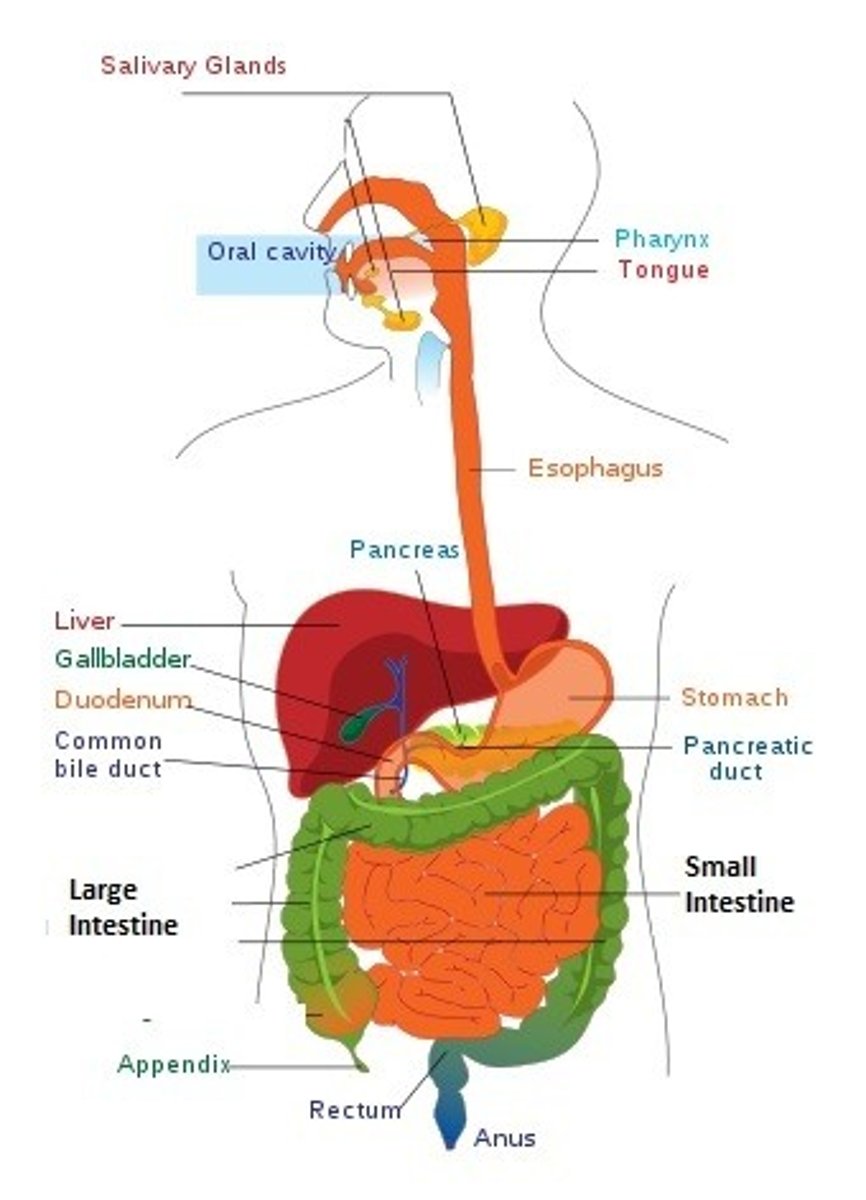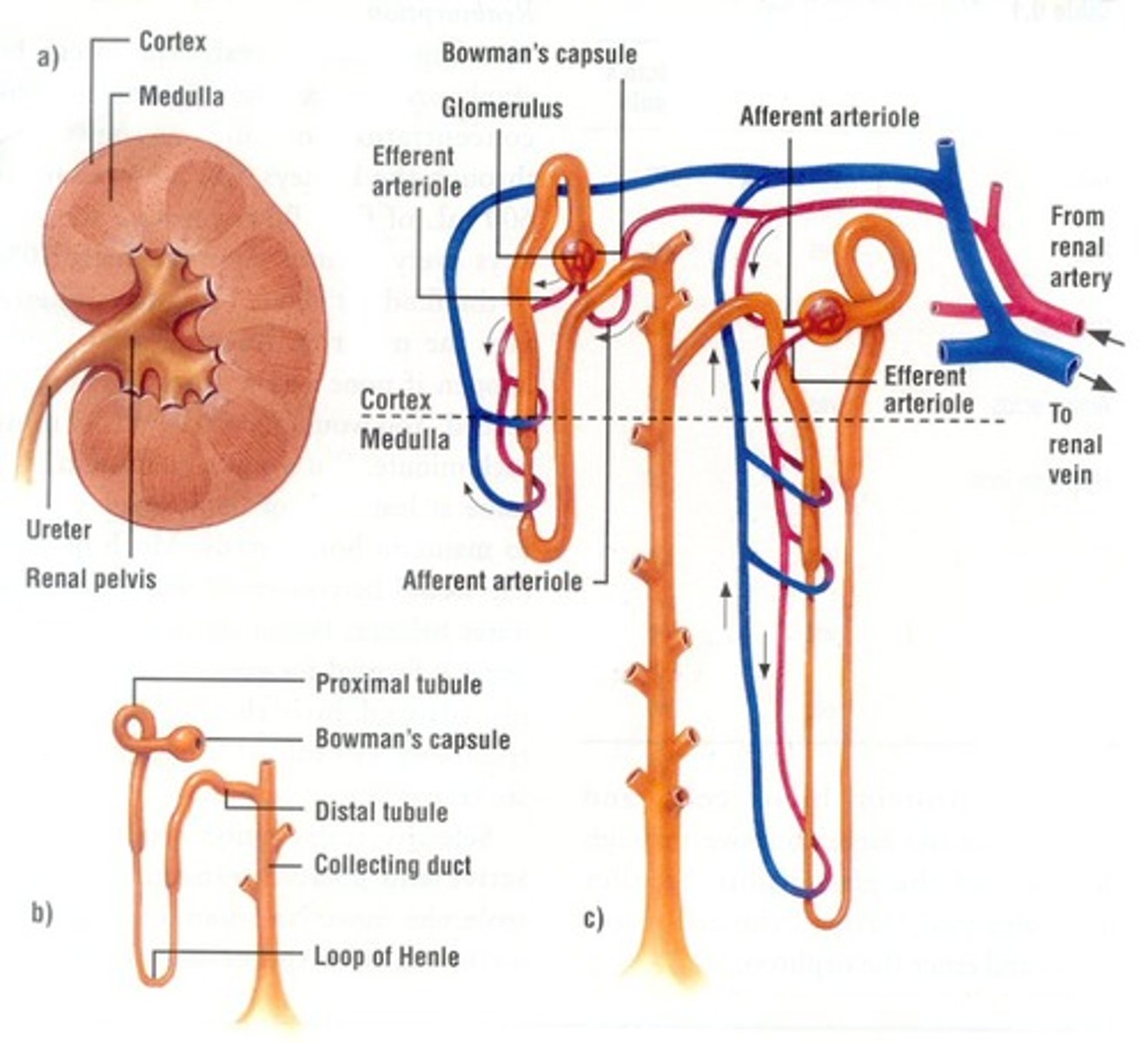TOPIC 6 and 11 - HUMAN PHYSIOLOGY (digestion, absorption, glucoregulation, leptin and excretion)
1/34
There's no tags or description
Looks like no tags are added yet.
Name | Mastery | Learn | Test | Matching | Spaced |
|---|
No study sessions yet.
35 Terms
Digestion
- large insoluble molecules are broken down by digestive enzymes into constituent monomers used as nutrients by cells to carry out respiration and cell growth
- Enzymes allow these reactions to happen at a sufficient rate at body temperature and cellulose is not digested
human digestive system diagram

Pancreatic enzymes
- these are secreted into the lumen of the duodenum together with alkaline salts to neutralize stomach juices
- the pancreas is controlled by the enteric nervous system and by hormones of the stomach
Amylase - breaks down starch to maltose at pH7
Maltase - breaks down maltose to glucose at pH7
Lipase - breaks down triglicerides to fatty acids and glycerol
Endopeptidase - breaks down proteins to small polypeptides
digestion of starch
- two types of starch molecules: amylopectin and amylose
- amylase can break amylose into maltose but cannot fully break 1,6 bonds in amylopectin leaving dextrins (fragments)
- Maltase and dextrinase in microvilli digest maltose and dextrins into glucose
- microvilli membrane use protein pumps to absorb glucose into blood which is taken through hepatic portal vein to liver where excess glucose is stored as glycogen
structure of the small intestine
duodenum: where bile an pancreatic juices meet to digest and neutralize stomach juices
illeum: absorptive region
Gut lumen
Longitudinal muscle
Circular muscle
Mucosa and submucosa
Epithelium with villi
Peristalsis
The combined contraction of circular and longitudinal muscles which mixes food with enzymes and moves foods along the gut
Dialysis tubing
they can be use for digestion investigation as an artificially permeable membrane
- enzyme and macromolecule placed inside tube in warm water bath
- 30 minutes later micromolecule found inside and outside the tube and macromolecule not found hence evidence for digestion
The villus
*Tiny folds in the wall of the epithelium which have microvilli which bring out a huge increase in surface area which absorbs monomer units and mineral ions of digestion
Villi structure
- Finger-like shape - large surface area
- Surface microvilli - huge surface area
- Surface cells with large number of mitochondria - active uptake of nutrients
- Dense capillary network - good blood supply to remove water soluble nutrients
- Lacteal - removal of lipid and vitamin nutrients connected to lymphatic system
Methods of absoprtion
Simple diffusion - hydrophobic substances such as fatty acids
Facilitated diffusion e.g. hydrophiollic nutrients such as sugars
Active transport e.g.mineral ions
Pinocytosis - small droplets of fluid are passed through membrane with vesicles e.g triglycerides and cholesterol
Lacteal absorption
- Fatty acids and monoglycerides diffuse though facilitated diffusion into villus cell
- They are recombined into tryglicerides which are then combined with phospholipids, cholesterol and proteins to make lipoproteins
- Fat soluble vitamins combine with lipoproteins
- These leave villus cell by exocytosis into lacteal and some enters the capillary
Capillary absorption
- Sodium ions are actively transported out of the villus cell creating a diffusion gradient
- Sodium ions combine with glucose or amino acid molecules to diffuse into the4 capillary through a facilitated diffusion co-transporter channel
glucoregulation
- blood glucose levels maintained between 4-8 millimoles
hyperglycemia - insulin secreted by beta-cells in pancreas stimulates liver conversion of glucose to glycogen, and cells are stimulated to absorb glucose and use it for respiration rather than fat
hypoglycemia - glucagon is secreted by alpha-cells in pancreas stimulates liver conversion of glycogen to glucose
diabetes
Type I:
- childhood onset
- immune system destroys beta-cell so insulin secreted becomes insufficient
- glucose levels are monitored and insulin injections are used to regulate them
Type II:
- adulthood onset
- target cells become insensitive to insulin and so injections are not effective
- low carbohydrate diets can control the condition
Thyroxin and metabolism
- hormone secreted by thyroid gland with iodine composition
- low iodine diet prevents its synthesis
- regulates body´s metabolic rate targeting most active cells in liver, muscle and brain
- implicated in heat generation by shivering and uncoupled cell respiration by brown adipose tissue
- helps control body temperature by constricting vessels in skin
overheating - hypothalamus detects raised temperature, thyroid gland secretes thyroxin, reduced metabolic rate, vasodilation and reduced respiration in BAT return body to normal temperature
underheating - opposite
Leptin and obesity
- Leptin is a hormone made by adipose cells that helps to regulate energy balance by inhibiting hunger.
- Leptin acts on the receptors in the arcuate nucleus (collection of neurons) of the hypothalamus to regulate appetite in order to achieve energy homeostasis
- The concentration of leptin in the blood is controlled by food intake and the amount of adipose tissue in the body
- If the amount of adipose tissue in an individual increases, then their concentrations of leptin also increases, leading to long term suppression of appetite and reduced food intake
- In obese individuals a decreased sensitivity to leptin can occur, resulting in an inability the recognize when they are full
- mice containing a recessive/recessive allele (ob/ob) produce a truncated version of the leptin hormone
- This led into severe obesity in these mice as the signal that tells the brain of the mice they are full (leptin) didn't work anymore
- Since most humans have quite a high leptin concentration, it was determined that the many of obesity cases where caused by a change in the receptor protein for leptin, not in the production of leptin
Melatonin and jet lag
- Melatonin levels generally begin to rise in the mid to late evening, remaining high for most of the night, and then drop in the early morning hours.
- Light from the sun can also affect how much melatonin your body produces
- Natural melatonin levels slowly drop with age
- The SCN of the hypothalamus and the pineal gland continual set the circadian rhythm of the place the person is departing from
- Jet lag will only last a few days, as the body adjusts to the new times when the light is detected by the cells in the retina during a different time period
define excretion
the removal of waste products of metabolism and potentially toxic waste
Nitrogenous waste products
ammonia: (fresh water fish and larvae) - toxic so secreted in high dilution thus only given out by organisms in water environments
urea: (mammals, marine fish and amphibians) - less toxic so can be excreted concentrated and energy is required to convert ammonia to urea but conserves water
uric acid: (birds and insects) - not toxic so it forms concentrated semi-solid paste, it is lighter than diluted urine for flying animals, and conserves a lot of water
osmoregulation
control of the internal solute concentration of a living organism
osmoconformers - do not attempt to maintain a constant internal solute concentration e.g. marine animals which may be a disadvantage to body processes
osmoregulators - maintain a constant solute concentration though this requires energy
define isotonic
solute concentration = bodily fluids
define hypotonic
solute concentration < bodily fluids which occurs a s a result of dehydration which may cause lethargy, dark urine, low blood pressure and seizures
define hypertonic
solute concentration > bodily fluids which occurs as a result of over-hydration which may cause delirium, blurred vision, coma and death
structure and function of the kidney
- has two functions: osmoregulation and excretion
structure of the nephron
glomerulus - ultrafiltration
proximal convoluted tubule - selective re-absorption
loop of henlé - produces hypertonic urine
distal convoluted tubule - adjusts solute concentrations and blood pH
collecting duct - osmoregulation

Ultrafiltration in glomerulus
- knot-like ball of blood capillaries
- 20% of plasma escapes due to very high blood pressure as efferent arteriole is narrower than afferent arteriole
- fenestrations would allow any molecule thorugh so there are two filters beyond:
basement membrane - gel outside of capillary with small gaps of protein fibres
filtration slits - narrow gaps between foot process of podocyte cells which wrap around the capillary
- filtrate contains all plasma substances but plasma proteins except HCG
selective reabsorption
- glomelural filtrate contains useful molecules as well as waste products which a selective reabsorbed in the proximal convoluted tubule
- microvilli project into the lumen which provides large surface area to absorb through active transport
- all glucose is reabsorbed, about 80% of minerals
- active transport creates a higher solute concentration in cells of the wall than in the flitrate of the tubule and so water moves to adjacent cells through osmosis
role of the loop of henlé
- descending limbs of the loop are very permeable to water but relatively impermeable to sodium ions and ascending limbs are the opposite
- ascending limbs pump sodium ions from the filtrate to the medulla through active transport creating an osmotic gradient
- some water escapes and dilutes fluids in the medulla however the filtrate that leaves the loop of henlé is more dilute showing that its purpose is to maintain higher solute concentration in the medulla
- distal convoluted tubule exchanges ions to adjust blood levels with filtrate
ADH and osmoregulation
- if the water content of the blood is too low, the pituitary gland secretes ADH which makes cells in collecting duct more permeable to reabsorb water into bloodstream by activating aquaporins in membranes
- if the water concentration of the blood is too high ADH is not secreted and highly diluted urine is produced
filtrate concentrations in nephron
- proteins do not pass glomerulus
- glucose does not pass proximal convoluted tubule
- urea increases constantly
use of urine tests
>blood cells - presence may be cause by infection or cancer
>glucose - indicates diabetes
>proteins - hCG indicates pregnancy but large amounts may show kidney failure
>drug tests
hemodialisis
blood is drawn out of vein in arm and passes through machine for 3 to 4 hours with dyalisate which contains:
- no urea and ideal metabolite concentrations to isolate diffusion of waste products
- hydrogen carbonate ions to reduce acidity of blood
high calcium ions and low potassium concentrations to replace potassium with calcium
- concentration that will cause excess water to be removed from blood
kidney transplants
- functioning kidneys are transplanted
- long term cure
- donor and recipient must be compatible blood groups
- kidney is connected with recipient´s ureter, renal vein and arteries
variations of kidney structure between species
- the more a species requires water conservation, the larger the thicker the medulla to allow for longer loop of henle for maximum re-absorption of water
- maximum solute concentration and concentration factor of urine are the measurements used and increase as species live in dry environments
malpighian tubule system
- circulatory system in insects uses hemolymph not blood pumped by a vessel
- malpighian tubules are narrow blind-ended tubules which extract waste products such as ammonia to convert to uric acid
- the flow of fluid is created through the transfer of ions through active transport creating concentration gradients for passive transport of water
- the solution produced is transferred to gut with digested food and transferred to rectum
- cells in rectum pump mineral ions and water is allowed to be reabsorbed to prevent achieve osmoregulation.